Summary :
◉ Bacterial Biochemical Metabolism
It is defined as the set of chemical transformations (anabolic and catabolic reactions), which ensure the development of bacterial constituents and their functioning. Thanks to very complete enzymatic equipment, all the chemical reactions of bacterial metabolism are catalyzed by specific enzymes.
Thus, metabolism is at the center of all life. The forces of evolution have shaped the metabolic process used by organisms for billions of years. Despite the diversity of chemical reactions that have developed, several aspects of metabolism are common to all organisms.
The study of bacterial metabolism makes it possible to define biochemical identification characters which represent essential criteria in the classification (or taxonomy) of bacteria.
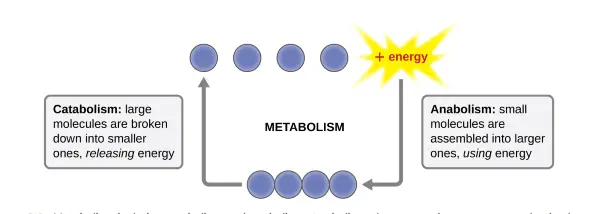
- Catabolic reactions allow the bacterium to convert the food available to it (Proteins, Lipids, Polysaccharides) into simple organic molecules or intermediate metabolites, with production of energy in the form of phosphate bond ADP ˜ Pi .
- Anabolic bonds are the biosynthetic pathways that bacteria take from these simple molecules to synthesize macromolecules involved in bacterial structure and function. The energy used in these biosyntheses comes from catabolism.
1- Energetic metabolism :
The bacterium produces energy during catabolism through so-called exergonic reactions. To avoid any loss in the form of heat, these exergonic (energy-producing) reactions are coupled with so-called endergonic (energy-absorbing) reactions. Energy is thus stored in chemical bonds such as the phosphate bond of ATP, or even immediately consumed in a reaction that requires it.
In bacteria of medical interest, which are chemoorganotrophs, exergonic reactions are oxidation reactions of an organic compound. From an SH2 substrate, the oxidation or dehydrogenation reaction causes the substrate, which is oxidized, to lose 2 electrons and 2 protons. Unable to remain free, the latter are ejected and then captured by an electron acceptor A which is thus reduced to AH2.
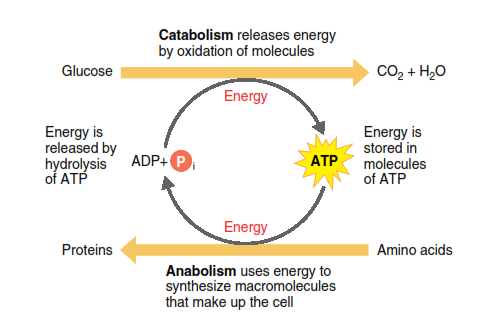
These 2 oxidation and reduction reactions are exergonic. The energy released is stored in ATP.
The energy metabolism of a chemoorganotrophic bacterium consists of a series of REDOX reactions with the release of energy, starting from an organic substrate.
The organic compound can be:
- A carbohydrate (especially glucose) the most important source of energy
- An amino acid
- An amino acid
- An alkane
- A purine or pyrimidine base
Energy-producing redox reactions are integrated into 2 types of energy processes: Fermentation and Respiration.
- Fermentation was defined by Pasteur as "life without air" In fact, it is a biological oxidation during which the final acceptor of H2 and e is an organic compound. This compound can be present in the medium or come from the degradation of an oxidizable substrate. The fermentation pathways take place within the bacterial cytoplasm. Energy is produced by phosphorylation at the substrate level. The energy balance is reduced.
- Respiration is the set of metabolic pathways during which molecular oxygen or inorganic or ionic oxygenated compounds play the role of electron and H2 acceptor in redox reactions. These pathways are linked to the cytoplasmic membrane of the bacterium. The energy is produced by so-called oxidative phosphorylation and released in stages via an electron transfer chain; The energy balance is high.

1-1) Intermediate metabolic pathways :
To oxidize a given energy substrate, there is a set of catabolic reactions common to many bacteria: These are the general pathways of energy metabolism or intermediate metabolism. Thus, the oxidation of glucose, considered as the most typical oxidizable energy substrate, takes the pathways of intermediate metabolism
There are 3 main enzymatic pathways, with cytoplasmic localization, which oxidize glucose to pyruvic acid, a veritable hub of metabolism and located at the crossroads of intermediate metabolism:
- The Embden-Meyerhof-Parnas (EMP) or Hexose-Diphosphate pathway
- The Hexose-Monophosphate pathway or Pentose-Phosphate pathway or Oxidative Shunt or Dickens-Horecker cycle
- The 2-keto-3-deoxy-gluconate pathway or Entner-Doudoroff pathway
During these intermediate glucose metabolism pathways, NADH2 molecules appear that microorganisms can, depending on the case, reoxidize. In aerobiosis, the final acceptor is molecular oxygen through the respiratory chain. In anaerobiosis, acceptors are organic compounds other than molecular oxygen
1-2) Breathing:
Pyuvate is mainly oxidized to Acetyl-Coenzyme A, these 2 compounds being at the crossroads of intermediate metabolism. Pyruvate is the obligatory end point of all the glucose degradation pathways and the oxidation pathways of many amino acids. It is transformed into Acetyl~CoA by oxidative decarboxylation
1-2-1) The Krebs cycle
- Acetyl~CoA reacts with oxaloacetic acid to form citric acid. Follows a succession of oxidation and decarboxylation reactions, with reductions of NAD to NADH2 coupled with oxidation reactions which make it possible to regenerate NAD+. From an energetic point of view, each turn of the Krebs cycle generates 4 dehydrogenation reactions
- For an Acetyl~CoA incorporated into the cycle, 3 NADH2 and 1 FADH2 are generated and 1 ATP is produced directly at the level of the cycle. The molecules of NADH2 and FADH2 will supply electrons to the coenzymes of the respiratory chain. During their passage in the chain, each NADH2 produces 3 ATP and each FADH2, 2 ATP. Thus, each turn of the cycle produces 12 ATP.
1-2-2) The respiratory chain
It is the cytochromic electron transfer chain, to which oxidative phosphorylations are associated. Its components are arranged sequentially according to their redox potential. The movement of electrons or protons along the chain takes place gradually from the most electronegative constituents to go towards the most electropositive constituent (O2).
These components are enzymes associated with prosthetic groups and which act as electron carriers.
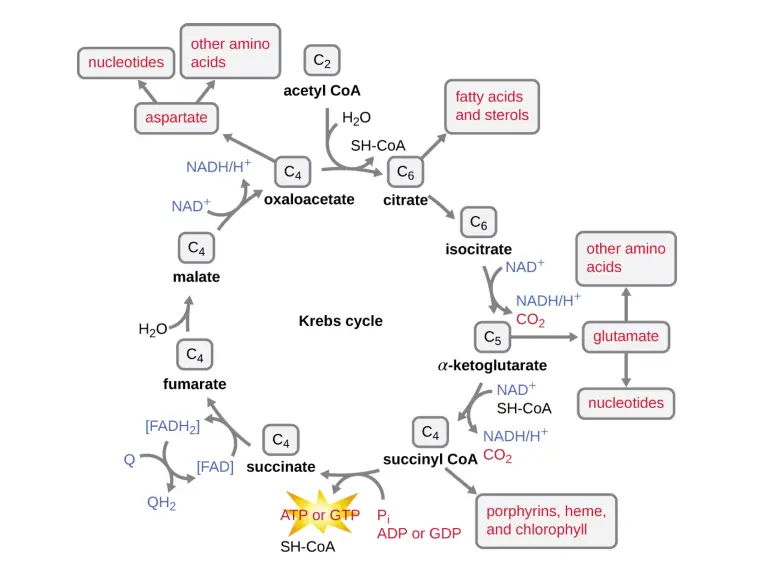
During respiration, there is a significant release of energy since there is oxidation of the substrate up to the H20+C02 stage. As a result, the oxidation of a substrate cannot be directly coupled to the reduction of the final acceptor, at the risk of burning the bacteria.
The energy is released step by step during a succession of redox reactions going from the reduction of NAD then of a flavoprotein and a ubiquinone with transfer of electrons and H2 to the final acceptor , the electrons being transferred by the cytochromes alone.
1-3) Glucose Fermentation
The first step involves the different pathways of intermediate metabolism that lead to Pyruvate. It is the Pyruvate reduction reactions that differentiate fermentative bacteria because they lead to various end products, either unique or more often mixed
We distinguish, according to the nature of the final fermentation products:
- Fermentation Complex Acids:
- Lactic acid fermentation
- Alcoholic Fermentation:
- Butyric Fermentation:
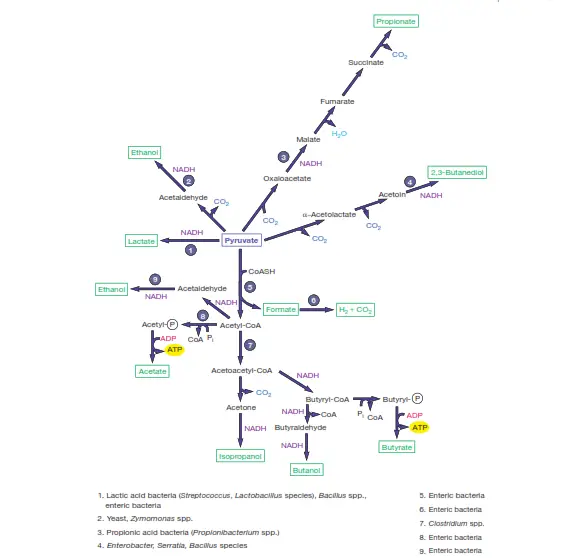
1-4) Energy metabolism exploration tests
- HUGH and LEIFSON proof (M.E.V.A.G)
- Oxidase test
- Catalase test
- Nitrate reductas test (GRIESS-ILOSWAY)
- Methyl red test (RM) and Voges-Proskauer reaction (VP)
- Use of Citrate as sole carbon source: Citrate test
2- Carbohydrate Metabolism :
There are 3 types of media to explore this metabolism;
- Simple Liquid Carbohydrate Media: Peptone Water + Sugar + pH Indicator
- Simple agar carbohydrate media: agar + sugar + pH indicator an example is: Mannitol-mobility-nitrate medium
- Complex carbohydrate agar media: TSI (Tri-Sugar-Iron ) and KIA (Kligler-Iron-agar )
3- Protein Metabolism:
It is studied in the laboratory by detecting protein metabolism enzymes, by bringing the bacteria into contact with the corresponding substrate.
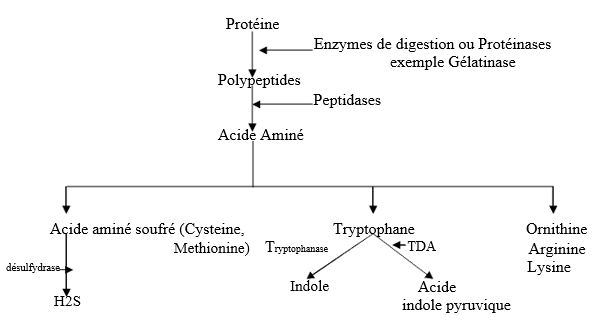
- H2S (Hydrogen Sulfide), released by reduction of a sulfur substrate (Sodium Thiosulfate), is precipitated in the form of iron sulfide in the presence of Ferric Citrate (or Ferric Sulfate) incorporated in the TSI agar.
- Catabolism of Ornithine, Arginine and Lysine
4- Lipid metabolism :
Lipids can only be assimilated once their molecule has been cleaved by hydrolysis, under the effect of enzymes generally called lipases. There are actually 3 groups of enzymes: Testing for esterases on TWEEN medium:
- Testing for esterases on TWEEN medium: SIERRA technique
- Search for lipases on Tributyrine medium: Glycerol Tributyrate, or Tributyrine, is used, which gives the agar a cloudy appearance. The presence of a lipase results in a clarification of the agar around the culture spot.
- Lecithinase research
◉ Applications of bacterial physiology :
1-Bacteriological diagnosis:
Bacterial physiology plays an essential role in the development of bacteriological diagnosis. Indeed, microscopic examination is only exceptionally sufficient to identify a bacterial species and it usually only represents an orientation step.
Most often, it is necessary to inoculate the pathological product on culture media containing nutrients essential for growth
The notions of bacterial physiology are then involved in the choice of the type(s) of culture media for the bacteria that one wishes to isolate or identify. We can distinguish :
- Isolation media: These are simple or complex solid media, on which many bacterial species can grow using a seeding technique that makes it possible to obtain easily identifiable separate colonies .
- Identification mediaSolid or liquid, they are used to highlight one or more metabolic characteristics of a previously isolated and purified bacterial strain. (The study of bacterial metabolism cannot be only on a pure bacterial strain).
- Selective media: Solids, they allow the isolation of a bacterial species while inhibiting the other species possibly present in a sample.
Ex: Chapman medium for Staphylococci Hektoen medium for Salmonella and Shigella. - Enrichment media: Liquids, they contain specific inhibitors of certain bacterial species and therefore promote the multiplication of given species. Ex: Selenite broth for Salmonella.
2- L'Antibiotic therapy:
Changes in the growth curve make it possible to measure the anti-bacterial activity of a new antibiotic on a given bacterium.
3-The effectiveness of sterilization :
The study of the growth curve makes it possible to check the rate of destruction of bacteria by heat, UV rays, or other physical or chemical agents.
4- Industry:
- Microbiological determination of vitamins and other substances which are growth factors for bacteria,
- Obtaining large amounts of antibiotics, enzymes and vitamins thanks to growth in renewed culture medium,
- Obtaining large quantities of bacteria intended for food, in particular animal feed (genetic engineering).
5- Blood culture systems :
Some suppliers have offered blood culture bottles with an integrated device to detect the first signs of culture through gases released by bacterial biochemical metabolism (Blood culture SIGNAL -OXOID), without an automated system.
However, there is a wide variety of automatons for blood cultures on the biomedical equipment market. The oldest, now outdated, detected the first signs of culture using the incorporation of C14 with a certain risk for the handler.
Currently, increasingly efficient automatons ensure the early detection of positive blood cultures based on the principle of detection of a product of biochemical metabolism, by risk-free techniques, such as the colorimetric technique practiced by the BACT/ALERT microbial Detection System automaton.
6- Biofilms :
In natural habitats, bacteria are attached to surfaces, more often than free suspended in a liquid medium. Thus, bacteria attached to surfaces organize themselves into a community by surrounding themselves with a matrix of organic polymers: the biofilm. It is in this form that bacteria colonize exploration or care equipment: Endoscopy, catheters, respiratory or urinary probes.
They would be protected from antimicrobial agents because they are at rest or in a state of latency that is not conducive to the action of antimicrobials.
The bacteria of biofilms impose a reflection in terms of hospital hygiene, prevention and disinfection of care equipment.
◉ Conclusion
Mastering the techniques for studying nutrition, the different metabolic pathways and bacterial growth cannot be achieved without understanding the molecular mechanisms involved in bacteria, both intracellularly and externally. scale of a bacterial population.